Out of 72 track stars, 20 run hurdles, 22 long jump, and 30 sprint. If 5 people sprint and also run hurdles, 4 people run hurdles and also long jump, 3 people sprint and also long jump, and 2 people do all 3, how many track stars do not do any of the events?
A. 10
B. 12
C. 14
D. 16
E. 18
I used the formula: Total = Group 1 + Group 2 + Group 3 - Both - 2*All3 + None
72 = 20 + 22 + 30 - 12 - 2(2) + N
N = 16
Please help me understand what I'm doing wrong because that is the wrong answer. Thanks!!!
Overlapping Set Problem
This topic has expert replies
-
GMATFrantic
- Newbie | Next Rank: 10 Posts
- Posts: 5
- Joined: Mon Jan 12, 2015 1:32 pm
- Thanked: 1 times
- GMATGuruNY
- GMAT Instructor
- Posts: 15539
- Joined: Tue May 25, 2010 12:04 pm
- Location: New York, NY
- Thanked: 13060 times
- Followed by:1906 members
- GMAT Score:790
Draw a VENN DIAGRAM representing the following:GMATFrantic wrote:Out of 72 track stars, 20 run hurdles, 22 long jump, and 30 sprint. If 5 people sprint and also run hurdles, 4 people run hurdles and also long jump, 3 people sprint and also long jump, and 2 people do all 3, how many track stars do not do any of the events?
A. 10
B. 12
C. 14
D. 16
E. 18
Total = 72
Hurdles = 20
Long jump = 22
Sprint = 30
None = ?
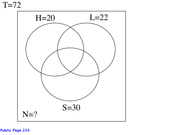
Complete the Venn diagram by working from the INSIDE OUT.
2 people do all 3:
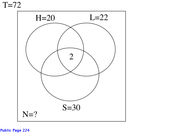
5 people sprint and also run hurdles.
4 people run hurdles and also long jump.
3 people sprint and also long jump.
Subtracting from these figures the 3 people who do all 3 events, we get:
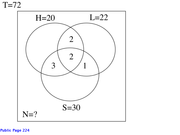
Subtracting the values in the diagram from H=20, L=22, and S=30, we get:
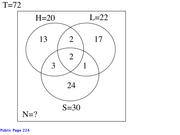
Subtracting the values in the diagram from Total = 72, we get:
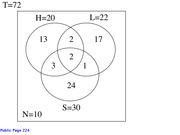
Thus:
N=10.
The correct answer is A.
Private tutor exclusively for the GMAT and GRE, with over 20 years of experience.
Followed here and elsewhere by over 1900 test-takers.
I have worked with students based in the US, Australia, Taiwan, China, Tajikistan, Kuwait, Saudi Arabia -- a long list of countries.
My students have been admitted to HBS, CBS, Tuck, Yale, Stern, Fuqua -- a long list of top programs.
As a tutor, I don't simply teach you how I would approach problems.
I unlock the best way for YOU to solve problems.
For more information, please email me (Mitch Hunt) at [email protected].
Student Review #1
Student Review #2
Student Review #3
Followed here and elsewhere by over 1900 test-takers.
I have worked with students based in the US, Australia, Taiwan, China, Tajikistan, Kuwait, Saudi Arabia -- a long list of countries.
My students have been admitted to HBS, CBS, Tuck, Yale, Stern, Fuqua -- a long list of top programs.
As a tutor, I don't simply teach you how I would approach problems.
I unlock the best way for YOU to solve problems.
For more information, please email me (Mitch Hunt) at [email protected].
Student Review #1
Student Review #2
Student Review #3
- GMATGuruNY
- GMAT Instructor
- Posts: 15539
- Joined: Tue May 25, 2010 12:04 pm
- Location: New York, NY
- Thanked: 13060 times
- Followed by:1906 members
- GMAT Score:790
In the formula above, both represents the number of people in EXACTLY 2 GROUPS.GMATFrantic wrote:Out of 72 track stars, 20 run hurdles, 22 long jump, and 30 sprint. If 5 people sprint and also run hurdles, 4 people run hurdles and also long jump, 3 people sprint and also long jump, and 2 people do all 3, how many track stars do not do any of the events?
A. 10
B. 12
C. 14
D. 16
E. 18
I used the formula: Total = Group 1 + Group 2 + Group 3 - Both - 2*All3 + None
But the prompt here does not give information about the number of people in exactly 2 groups.
Instead, it gives information about the number of people in AT LEAST 2 GROUPS:
5 people sprint and also run hurdles = people who do AT LEAST these 2 events = (sprint + hurdles) + (all 3 events).
4 people run hurdles and also long jump = people who do AT LEAST these 2 events = (hurdles + long jump) + (all 3 events).
3 people sprint and also long jump = people who do AT LEAST these 2 events = (sprint + long jump) + (all 3 events).
When given information about the number of people in AT LEAST 2 GROUPS, we can use the following formula:
T = G� + G₂ + G₃ - (at least 2) + (all 3) + N.
In the problem above, we get:
72 = 20 + 22 + 30 - (5 + 4 + 3) + 2 + N
72 = 62 + N
N = 10.
The correct answer is A.
Private tutor exclusively for the GMAT and GRE, with over 20 years of experience.
Followed here and elsewhere by over 1900 test-takers.
I have worked with students based in the US, Australia, Taiwan, China, Tajikistan, Kuwait, Saudi Arabia -- a long list of countries.
My students have been admitted to HBS, CBS, Tuck, Yale, Stern, Fuqua -- a long list of top programs.
As a tutor, I don't simply teach you how I would approach problems.
I unlock the best way for YOU to solve problems.
For more information, please email me (Mitch Hunt) at [email protected].
Student Review #1
Student Review #2
Student Review #3
Followed here and elsewhere by over 1900 test-takers.
I have worked with students based in the US, Australia, Taiwan, China, Tajikistan, Kuwait, Saudi Arabia -- a long list of countries.
My students have been admitted to HBS, CBS, Tuck, Yale, Stern, Fuqua -- a long list of top programs.
As a tutor, I don't simply teach you how I would approach problems.
I unlock the best way for YOU to solve problems.
For more information, please email me (Mitch Hunt) at [email protected].
Student Review #1
Student Review #2
Student Review #3
-
ahahkhyati.j
- Junior | Next Rank: 30 Posts
- Posts: 13
- Joined: Sat Oct 03, 2015 1:46 pm
GMATFrantic wrote:Out of 72 track stars, 20 run hurdles, 22 long jump, and 30 sprint. If 5 people sprint and also run hurdles, 4 people run hurdles and also long jump, 3 people sprint and also long jump, and 2 people do all 3, how many track stars do not do any of the events?
A. 10
B. 12
C. 14
D. 16
E. 18
I used the formula: Total = Group 1 + Group 2 + Group 3 - Both - 2*All3 + None
72 = 20 + 22 + 30 - 12 - 2(2) + N
N = 16
Please help me understand what I'm doing wrong because that is the wrong answer. Thanks!!!
Hi
I guess the mistake you made is all these three numbers 5, 4 and 3 include 2 as ONLY is not mentioned in the question. So infact you deducted 2 5 times instead of 2. So your answer is 6 more. In my opinion the answer should be 10.
GMAT/MBA Expert
- Brent@GMATPrepNow
- GMAT Instructor
- Posts: 16207
- Joined: Mon Dec 08, 2008 6:26 pm
- Location: Vancouver, BC
- Thanked: 5254 times
- Followed by:1268 members
- GMAT Score:770
Here's a free video demonstrating Mitch's diagram approach - https://www.gmatprepnow.com/module/gmat- ... /video/921
Here's a question to practice with - https://www.gmatprepnow.com/module/gmat- ... /video/922
Cheers,
Brent
Here's a question to practice with - https://www.gmatprepnow.com/module/gmat- ... /video/922
Cheers,
Brent




















